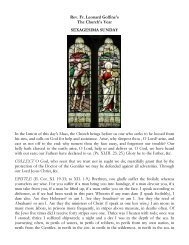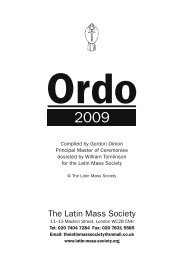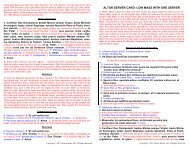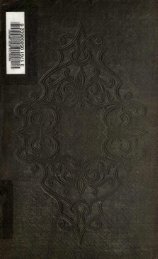The Spirit of Gregorian Chant - Church Music Association of America
The Spirit of Gregorian Chant - Church Music Association of America
The Spirit of Gregorian Chant - Church Music Association of America
Create successful ePaper yourself
Turn your PDF publications into a flip-book with our unique Google optimized e-Paper software.
46 THE SPIRIT OF GREGORIAN CHANT<br />
Among the letters used in this manuscript to help determine the<br />
intonation <strong>of</strong> the neums is found a supplementary sign (|—), con"<br />
sisting <strong>of</strong> two lines, diversely placed against one another according<br />
to the note for which the sign substitutes at places where a half'<br />
tone exists. <strong>The</strong> quarter'tone, the diesis, for which this episema<br />
(Gr. episema, mark or sign) is sometimes deciphered, was, according<br />
to Dom Pothier, probably particular only to the discourse <strong>of</strong><br />
the ancients; for, he asserts, their delicate appreciation <strong>of</strong> tones and<br />
sense <strong>of</strong> euphony might well have designated by a quarter'tone in<br />
music that which corresponded at its origin to the ordinary music<br />
<strong>of</strong> discourse. Even in the most precise melodies one can find pas'<br />
sages which seem to approach vaguely the tone <strong>of</strong> simple speech,<br />
passages where one recognizes the quarter'tone <strong>of</strong> the spoken word<br />
without the song ceasing to belong to a really diatonic order. 1 An'<br />
other authority maintains, however, that this episema does denote<br />
a quarter'tone. 2<br />
<strong>Gregorian</strong> <strong>Chant</strong> was at first entrusted to the memory <strong>of</strong> the<br />
singers and to tradition by oral training. Neums were used merely<br />
for recalling to the memory that which was already known, just as<br />
Hebrew mnemonic signs suffice for the cantor. 3 Neums were, how<br />
ever, insufficient at their origin for transmitting integrally an un'<br />
known melody.<br />
It took years for the early medieval chanter, by work and perse'<br />
verance, to know the Antiphonary. To assist his memory he used<br />
timbres (fixed melodies). Guido, in describing these, points out the<br />
fact that there are eight Modes as there are eight parts <strong>of</strong> speech and<br />
eight Beatitudes, and that each Mode has its special nuances. In<br />
order to distinguish the Modes, eight Tone phrases were composed,<br />
each one with special characteristics <strong>of</strong> a particular Mode. <strong>The</strong>se<br />
familiar melodies were compared with the unknown melody to reveal<br />
the Mode <strong>of</strong> the latter. <strong>The</strong>se model melodic types were fitted to<br />
words from Holy Scripture, and had long tonal formulas <strong>of</strong> Byzantine<br />
style. <strong>The</strong>y were employed by the chanters merely as prototypes<br />
for practice work, and not for liturgical use, and are found in<br />
*Les Mel. Grig., Ch. III. 2 J. Gmelchs, Die Viertelstonstufen im Messtonale von Montpellier, Ref.,<br />
New School <strong>of</strong> Greg. <strong>Chant</strong>, Ch. II, Part 2. »Les Mel. Grig., Ch. III.
















